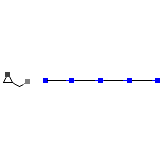Chloromerodrin




Chloromerodrin Brand names, Chloromerodrin Analogs
Chloromerodrin Brand Names Mixture
- No information avaliable
Chloromerodrin Chemical_Formula
C11H28ClN5O
Chloromerodrin RX_link
http://www.rxlist.com/cgi/generic/colestipol.htm
Chloromerodrin fda sheet
Chloromerodrin msds (material safety sheet)
Chloromerodrin Synthesis Reference
No information avaliable
Chloromerodrin Molecular Weight
281.826 g/mol
Chloromerodrin Melting Point
No information avaliable
Chloromerodrin H2O Solubility
Insoluble
Chloromerodrin State
Solid
Chloromerodrin LogP
-2.206
Chloromerodrin Dosage Forms
Tablets containing 1 gram of colestipol hydrochloride (light yellow in color and are tasteless and odorless)
Chloromerodrin Indication
For use, as adjunctive therapy to diet, for the reduction of elevated serum total and LDL-C in patients with primary hypercholesterolemia (elevated LDL-C) who do not respond adequately to diet.
Chloromerodrin Pharmacology
Cholesterol is the major, and probably the sole precursor of bile acids. During normal digestion, bile acids are secreted via the bile from the liver and gall bladder into the intestines. Bile acids emulsify the fat and lipid materials present in food, thus facilitating absorption. A major portion of the bile acids secreted is reabsorbed from the intestines and returned via the portal circulation to the liver, thus completing the enterohepatic cycle. Only very small amounts of bile acids are found in normal serum. Colestipol hydrochloride binds bile acids in the intestine forming a complex that is excreted in the feces. This nonsystemic action results in a partial removal of the bile acids from the enterohepatic circulation, preventing their reabsorption. Since colestipol hydrochloride is an anion exchange resin, the chloride anions of the resin can be replaced by other anions, usually those with a greater affinity for the resin than the chloride ion.
Chloromerodrin Absorption
Not absorbed from the gastrointestinal tract.
Chloromerodrin side effects and Toxicity
Oral LD50 in rats is > 1000 mg/kg. Symptoms of overdose may include eye irritation, constipation, abdominal cramps, nausea, vomiting, diarrhea, and hypersensitivity. However, as colestipol is not absorbed, the risk of systemic toxicity is low.
Chloromerodrin Patient Information
Chloromerodrin Organisms Affected
Humans and other mammals














